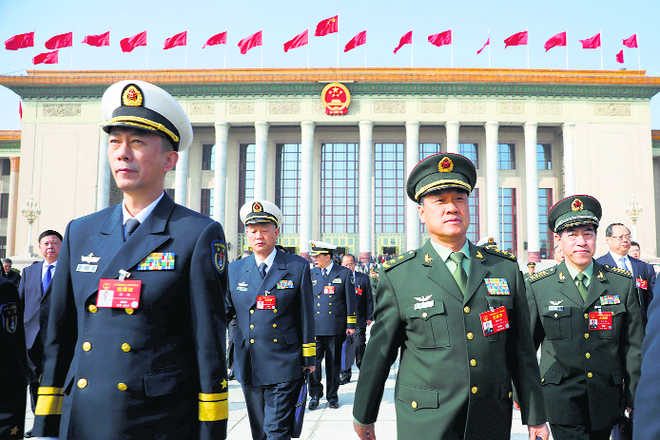
GAP: China is already spending 3.5 times higher than India’s defence budget.
Bhartendu Kumar Singh
Indian Defence Accounts Service
UNDERSTANDING China’s defence budget is a difficult exercise. While the traditional knowledge gap between global perceptions and Chinese official pronouncements has narrowed in recent years, the mystery remains. Therefore, when China hiked its 2019 defence budget recently by 7.5 per cent to $177.5 billion, the official narrative of the single-digit growth since 2016 due to ‘slow economic growth’ was unconvincing. China still hides its correct defence budget and finances them from discreet sources; the traditional correlation between the GDP growth rate and the defence budget is being diluted. China will fund its military modernisation process, irrespective of its economic performance.
After years of rapid growth, China’s GDP is growing slowly, though from a much higher base. For some Chinese, the slowing growth is a natural consequence of a maturing economy. Officially, China has been very candid about this, as reflected in this year’s Work Report that speaks of a lower GDP target of 6 to 6.5 per cent against 6.5 per cent last year. This is a sharp fall from the double-digit growth until a few years ago and reflects China’s slowing economy and uncertainty in futuristic outcomes. It is also true that the double-digit growth of economy in the past enabled China to facilitate double-digit hikes for the defence budget. In the process, China became the second largest defence budget holder and military power after the US.
However, China’s sluggish economic growth would not anyway constrain a liberal dose for the defence budget. Several factors allude to this reality. First, China’s PLA (People’s Liberation Army) is undergoing a massive structural, technological and operational transformation. While China would save some money due to manpower reduction of 3 lakh soldiers from the PLA’s payrolls by 2020, it would still need more to finance its various activities in high-tech military power. The military R&D, for instance, has started paying dividends and needs further push for self-sustenance in leapfrogging technologies. Second, China is almost bogged down with the immediate issues of Taiwan and South China Sea, where its military confidence and resilience is being severely tested by regional players in alliance with the US. China has made huge financial investments in shoring up its confidence, but the tempo needs to be maintained for dominating the game in the long term. Third, Chinese official and unofficial figures are not even one-third of the US defence budget, proposed at $750 billion for 2019. With this money, China can only tease the Americans and not challenge or harm them.
Even if Chinese facts, figures and statements on the defence budget are taken at face value, they still reflect a larger base. So, even a marginal increase in percentage terms converts to substantial amount in real terms and enables China to widen the gap with other countries with the sole exception of the US. According to the Military Balance 2019, Russia-China defence budget gap has widened significantly in the past decade. In 2008, China spent 1.5 times more than Russia on estimated total military expenditure. In 2017, this gap increased to 2.4 times, when measured in real terms. China is already spending 3.5 times higher than the Indian defence budget. Much of Chinese increases have come between 2006 and 2016, during which the global defence expenditure was almost stagnant or rose marginally like 1.1 per cent in 2017. It emerges, therefore, that global recession or its own slow growth do not cut into the Chinese defence budget growth.
Beyond numerical polemics, what distinguishes China’s defence budget is its capability to optimise expenditure, best reflected in its political economy of development, military modernisation and a grand strategy. For the first two decades of economic reforms under Deng Xiaoping, China focused on agricultural, industrial and trade reforms as part of ‘four modernisations’. Military reforms were the last priority. Thus, China had ample time and resources to focus on development issues. This approach validates the primacy of butter in the ‘guns vs butter debate’. China’s defence modernisation is another test case. Here is a country that swiftly converted itself from being the largest arms importer to a lead exporter. China produces almost all big-ticket military items and has indeed emerged as the lead producer of ships. Very few countries have brought about such a large-scale metamorphosis (from import substitution to self-reliance and export capabilities) of their domestic military industrial complex (MIC) as China has managed. China is not only creating domestic jobs; it is also becoming a technology leader, and above all, producing weaponry at cheaper rates and saving the precious penny earlier spent on costly imports. China’s political economy approach is also evident in its grand strategy through avoidance of outright conflicts with the US, selective pinching and teasing the US, selling weapons at competitive rates in reciprocation for political support, and above all, leasing of foreign bases and ports and engaging host countries in informal coalition-building exercises. China has also positioned PLA troops to secure its interests under the Belt and Road Initiative (BRI) in Pakistan, something that was not practised earlier.
While it is unfortunate that Sinologists have not been able to correctly assess China’s actual defence budget despite proliferation in assessment tools and techniques, the bigger tragedy is that many scholars continue to be victims of ‘contradictory wisdom’ and remain trapped between opposite views on China’s defence budget. It would be better, instead, to focus on China’s increasingly aggressive strategic behaviour with a rise in relative capabilities under Xi Jinping.
Views are personal

























